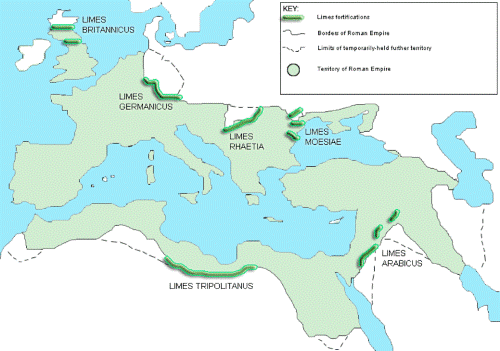Rome vs Persia - The Eternal War
Though not spoken of, when you have 700 hundred years of war with the Persian Empire it only makes sense that a line of fortifications was built on the Eastern Front.
So while surfing the net I found a 2013 article titled "Military Infrastructure in the Eastern Roman Provices." If you have trouble sleeping at night then articles like this are the cure. Still it brought forward some ignored information on a forgotten Roman Limes system in Armenia.
Rome's eastern defenses were remodeled from the 3rd century on to cope with the growing power of the Persian Empire under the Sassanid Dynasty.
The defensive system adapted to meet the terrain with fortified cities, fortresses, forts and fortified highland redoubts. All of these were supported by a series of Roman roads to speed the movement of troops.
Over time the Roman military focused more to the north in Armenia and the desert south was left to Christian Arab allied tribes.
Very little infrastructure remains - - - What exists is largely tiny amounts of rubble.
The fortifications served two functions: 1) They provided a barrier against Persian invasion and 2) bases for offensive Roman military action against Persia.
Over the centuries Rome spent mountains of gold in the east building every possible type of defensive structure to hold off a Persian invasion.
The big problem is almost NOTHING remains to be seen. The limes system has virtually turned to dust.
The city of Satala in central Anatolia is a good example of the Anatolia Limes system of eastern fortifications.
As a frontline fortress against Persia, Satala was the Roman legionary base, used by XVI Flavia Firma and XV Apollinaris.
After the conquest of Mesopotamia by Septimius Severus in the last decade of the second century, Satala was still a front city, but the Armenian province across the Euphrates, the district known as Sophene, posed no direct military threat. However, occupation of this site remained vital, because Satala still was the main connection between the Black Sea, the river and Antioch near the Mediterranean in the south.
The border wars both larger and smaller continued on and on for centuries with little real change in the border.
Satala shows us the vanished Armenian limes. and the endless money needed to keep the forts repaired.
The site was fortified again in 529 by the emperor Justinian. His historian Procopius writes:
- "The city of Satala had been in a precarious state in ancient times. For it is situated not far from the land of the enemy and it also lies in a low-lying plain and is dominated by many hills which tower around it, and for this reason it stood in need of circuit-walls which would defy attack. Nevertheless, even though its surroundings were of such a nature as this, its defenses were in a perilous condition, having been carelessly constructed with bad workmanship in the beginning, and with the long passage of time the masonry had everywhere collapsed. But the Emperor tore all this down and built there a new circuit wall, so high that it seemed to overtop the hills around it, and of a thickness sufficient to ensure the safety of its towering mass. And he set up admirable outworks on all sides and so struck terror into the hearts of the enemy."
The fortress of Satala survived for almost a century after Procopius wrote, but was eventually captured and destroyed in 607/608 by the Sasanian King Khusrau II (r.590-628).
The reason of this defensive "Limes" was to protect the Roman "Province of Arabia" from attacks of the barbarian tribes of the Arabian desert.
https://www.academia.edu/4385960/Military_Infrastructure?email_work_card=thumbnail
https://www.livius.org/articles/place/satala-sadak/
https://en.wikipedia.org/wiki/Limes_(Roman_Empire)










